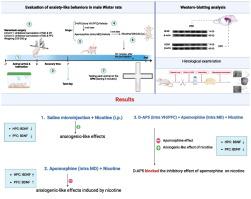Pharmacology Biochemistry and Behavior ( IF 3.6 ) Pub Date : 2023-09-29 , DOI: 10.1016/j.pbb.2023.173650 Seyedeh Leila Mousavi 1 , Ameneh Rezayof 2 , Sakineh Alijanpour 3 , Ladan Delphi 2 , Oveis Hosseinzadeh Sahafi 4

|
The present study aimed to evaluate the functional interaction between the dopaminergic and glutamatergic systems of the mediodorsal thalamus (MD), the ventral hippocampus (VH), and the prefrontal cortex (PFC) in nicotine-induced anxiogenic-like behaviors. Brain-derived neurotrophic factor (BDNF) level changes were measured in the targeted brain areas following the drug treatments. The percentage of time spent in the open arm (% OAT) and open arm entry (% OAE) were calculated in the elevated plus maze (EPM) to measure anxiety-related behaviors in adult male Wistar rats. Systemic administration of nicotine at a dose of 0.5 mg/kg induced an anxiogenic-like response associated with decreased BDNF levels in the hippocampus and the PFC. Intra-MD microinjection of apomorphine (0.1–0.3 μg/rat) induced an anxiogenic-like response, while apomorphine inhibited nicotine-induced anxiogenic-like behaviors associated with increased hippocampal and PFC BDNF expression levels. Interestingly, the blockade of the VH or the PFC NMDA receptors via the microinjection of D-AP5 (0.3–0.5 μg/rat) into the targeted sites reversed the inhibitory effect of apomorphine (0.5 μg/rat, intra-MD) on the nicotine response and led to the decrease of BDNF levels in the hippocampus and the PFC. Also, the microinjection of a higher dose of D-AP5 (0.5 μg/rat, intra-PFC) alone produced an anxiogenic effect. These findings suggest that the functional interaction between the MD dopaminergic D1/D2-like and the VH/PFC glutamatergic NMDA receptors may be partially involved in the anxiogenic-like effects of nicotine, likely via the alteration of BDNF levels in the hippocampus and the PFC.
中文翻译:

丘脑内侧多巴胺受体的激活抑制尼古丁诱导的大鼠焦虑:皮质边缘 NMDA 神经传递和 BDNF 表达的可能作用
本研究旨在评估尼古丁诱导的焦虑样行为中丘脑内侧(MD)、腹侧海马(VH)和前额皮质(PFC)的多巴胺能和谷氨酸能系统之间的功能相互作用。在药物治疗后,测量了目标大脑区域的脑源性神经营养因子(BDNF)水平变化。计算高架十字迷宫 (EPM) 中花在开臂 (% OAT) 和开臂进入 (% OAE) 的时间百分比,以测量成年雄性 Wistar 大鼠的焦虑相关行为。全身给予 0.5 mg/kg 剂量的尼古丁会引起与海马和 PFC 中 BDNF 水平降低相关的类焦虑反应。MD内微注射阿扑吗啡(0.1-0.3 μg/大鼠)诱导了类似焦虑的反应,而阿扑吗啡抑制了尼古丁诱导的与海马和PFC BDNF表达水平增加相关的焦虑样行为。有趣的是,通过将 D-AP5(0.3-0.5 μg/大鼠)显微注射到目标位点来阻断 VH 或 PFC NMDA 受体,逆转了阿扑吗啡(0.5 μg/大鼠,MD 内)对尼古丁的抑制作用反应并导致海马和前额皮层 BDNF 水平下降。此外,单独显微注射较高剂量的 D-AP5(0.5 μg/大鼠,PFC 内)会产生致焦虑作用。这些发现表明,MD 多巴胺能 D1/D2 样受体和 VH/PFC 谷氨酸能 NMDA 受体之间的功能相互作用可能部分参与尼古丁的类焦虑作用,可能是通过改变海马和 PFC 中 BDNF 水平来实现的。 。



























 京公网安备 11010802027423号
京公网安备 11010802027423号